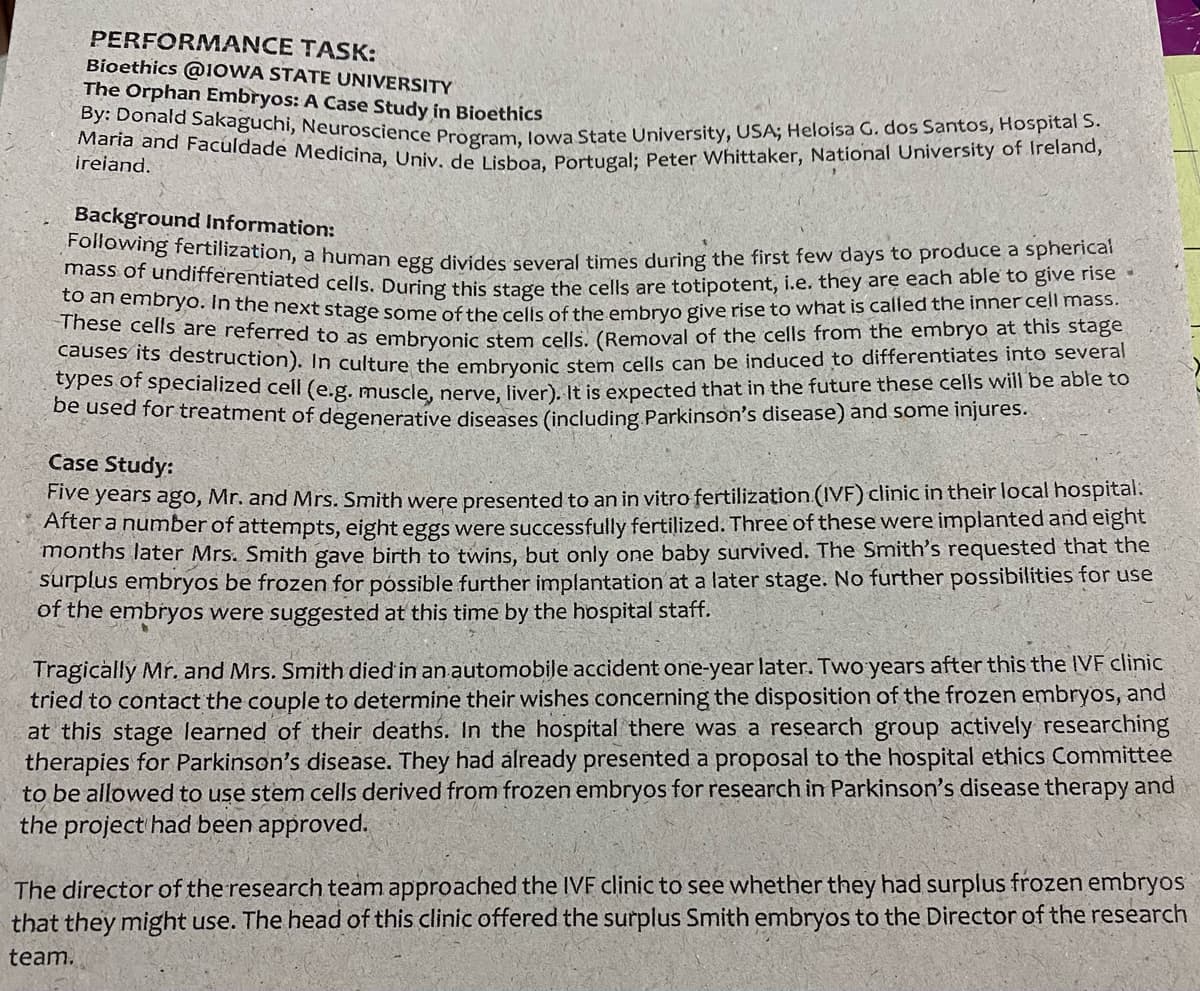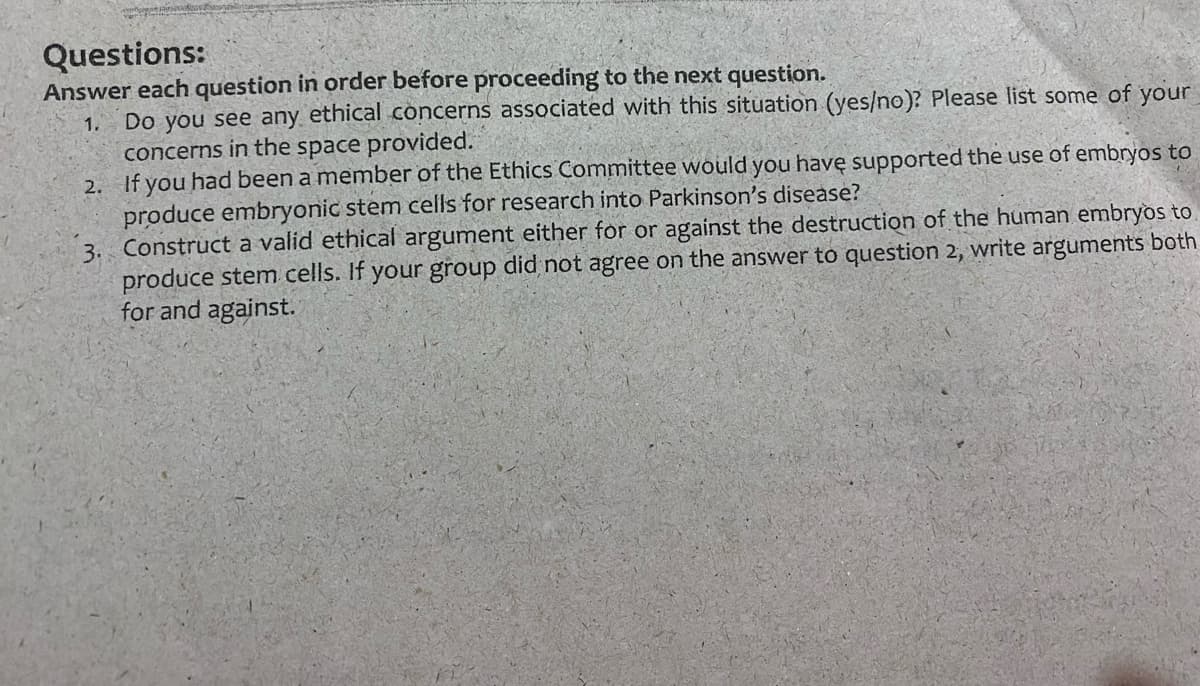Questions: Answer each question in order before proceeding to the next question. Do you see any ethical concerns associated with this situation (yes/no)? Please list some of your concerns in the space provided. 2. If you had been a member of the Ethics Committee would you havę supported the use of embryos to produce embryonic stem cells for research into Parkinson's disease? 3. Construct a valid ethical argument either for or against the destruction of the human embryos to produce stem cells. If your group did not agree on the answer to question 2, write arguments both for and against. 1.
Questions: Answer each question in order before proceeding to the next question. Do you see any ethical concerns associated with this situation (yes/no)? Please list some of your concerns in the space provided. 2. If you had been a member of the Ethics Committee would you havę supported the use of embryos to produce embryonic stem cells for research into Parkinson's disease? 3. Construct a valid ethical argument either for or against the destruction of the human embryos to produce stem cells. If your group did not agree on the answer to question 2, write arguments both for and against. 1.
Human Biology (MindTap Course List)
11th Edition
ISBN:9781305112100
Author:Cecie Starr, Beverly McMillan
Publisher:Cecie Starr, Beverly McMillan
Chapter17: Development And Aging
Section: Chapter Questions
Problem 5SQ: _________ is the gene-guided process by which cells in different locations in the embryo become...
Related questions
Question
Please read the first picture and answer the second picture. Hope you can answer correctly,thankyou!

Transcribed Image Text:types of specialized cell (e.g. muscle, nerve, liver). It is expected that in the future these cells will be able to
causes its destruction). In culture the embryonic stem cells can be induced to differentiates into several
mass of undifferentiated cells. During this stage the cells are totipotent, i.e. they are each able to give rise
Following fertilization, a human egg divides several times during the first few days to produce a spherical
Maria and Faculdade Medicina, Univ. de Lisboa, Portugal; Peter Whittaker, National University of Ireland,
By: Donald Sakaguchi, Neuroscience Program, lowa State University, USA; Heloisa G. dos Santos, Hospital S.
PERFORMANCE TASK:
Bioethics @IOWA STATE UNIVERSITY
The Orphan Embryos: A Case Study in Bioethics
ireiand.
Background Information:
o an embryo. In the next stage some ofthe cells of the embrvo give rise to what is called the inner cell mass.
iese celis are referred to as embrvonic stem cells, (Removal of the cells from the embryo at this stage
be used for treatment of degenerative diseases (including Parkinson's disease) and some injures.
Case Study:
ive years ago, Mr. and Mrs. Smith were presented to an in vitro fertilization (IVF) clinic in their local hospital.
Aftera number of attempts, eight eggs were successfully fertilized. Three of these were implanted and eight
months later Mrs. Smith gave birth to twins, but only one baby survived. The Smith's requested that the
surplus embryos be frozen for póssible further implantation at a later stage. No further possibilities for use
of the embryos were suggested at this time by the hospital staff.
Tragically Mr. and Mrs. Smith died in an automobile accident one-year later. Two years after this the IVF cliniC
tried to contact the couple to determine their wishes concerning the disposition of the frozen embryos, and
at this stage learned of their deaths. In the hospital there was a research group actively researching
therapies for Parkinson's disease. They had álready presented a proposal to the hospital ethics Committee
to be allowed to use stem cells derived from frozen embryos for research in Parkinson's disease therapy and
the project had been approved.
The director of the research team approached the IVF clinic to see whether they had surplus frozen embryos
that they might use. The head of this clinic offered the surplus Smith embryos to the Director of the research
team.

Transcribed Image Text:Questions:
Answer each question in order before proceeding to the next question.
Do you see any ethical concerns associated with this situation (yes/no)? Please list some of your
concerns in the space provided.
2. If you had been a member of the Ethics Committee would you havę supported the use of embryos to
produce embryonic stem cells for research into Parkinson's disease?
3. Construct a valid ethical argument either for or against the destruction of the human embryos to
produce stem cells. If your group did not agree on the answer to question 2, write arguments both
for and against.
1.
Expert Solution
This question has been solved!
Explore an expertly crafted, step-by-step solution for a thorough understanding of key concepts.
Step by step
Solved in 3 steps

Knowledge Booster
Learn more about
Need a deep-dive on the concept behind this application? Look no further. Learn more about this topic, biology and related others by exploring similar questions and additional content below.Recommended textbooks for you

Human Biology (MindTap Course List)
Biology
ISBN:
9781305112100
Author:
Cecie Starr, Beverly McMillan
Publisher:
Cengage Learning

Biology Today and Tomorrow without Physiology (Mi…
Biology
ISBN:
9781305117396
Author:
Cecie Starr, Christine Evers, Lisa Starr
Publisher:
Cengage Learning

Biology 2e
Biology
ISBN:
9781947172517
Author:
Matthew Douglas, Jung Choi, Mary Ann Clark
Publisher:
OpenStax

Human Biology (MindTap Course List)
Biology
ISBN:
9781305112100
Author:
Cecie Starr, Beverly McMillan
Publisher:
Cengage Learning

Biology Today and Tomorrow without Physiology (Mi…
Biology
ISBN:
9781305117396
Author:
Cecie Starr, Christine Evers, Lisa Starr
Publisher:
Cengage Learning

Biology 2e
Biology
ISBN:
9781947172517
Author:
Matthew Douglas, Jung Choi, Mary Ann Clark
Publisher:
OpenStax